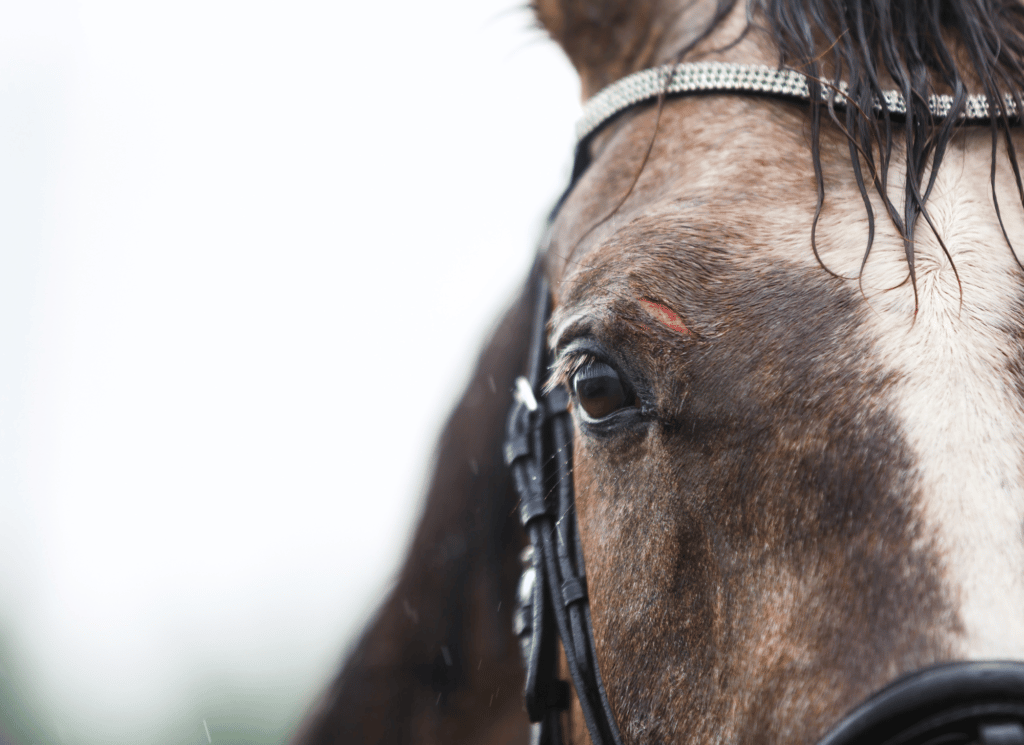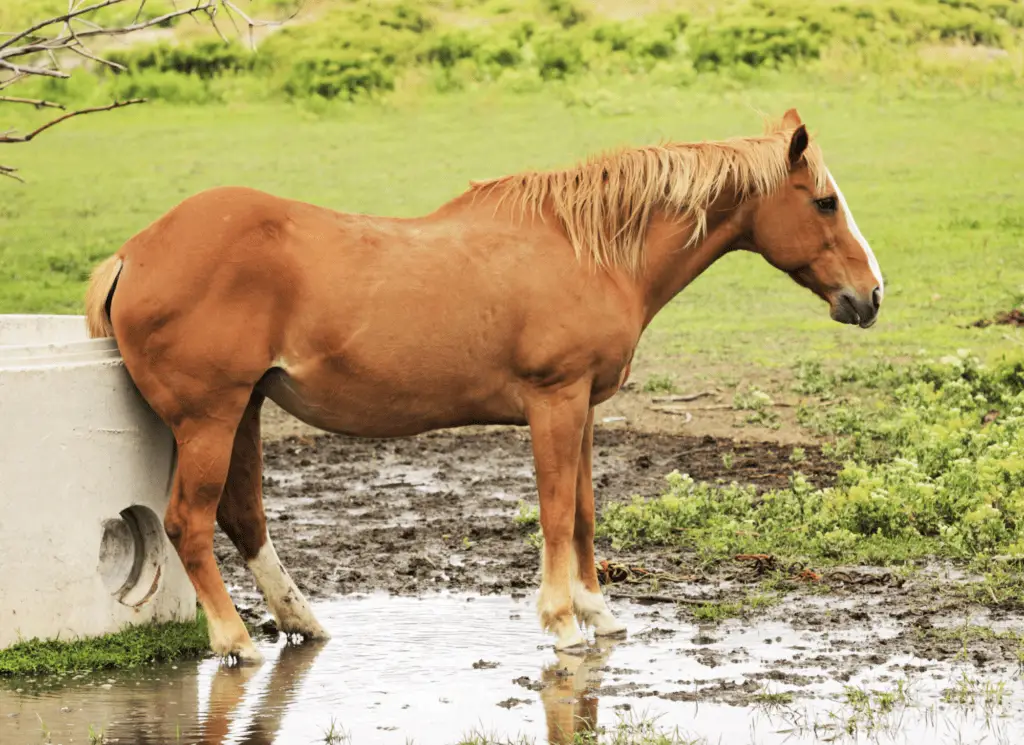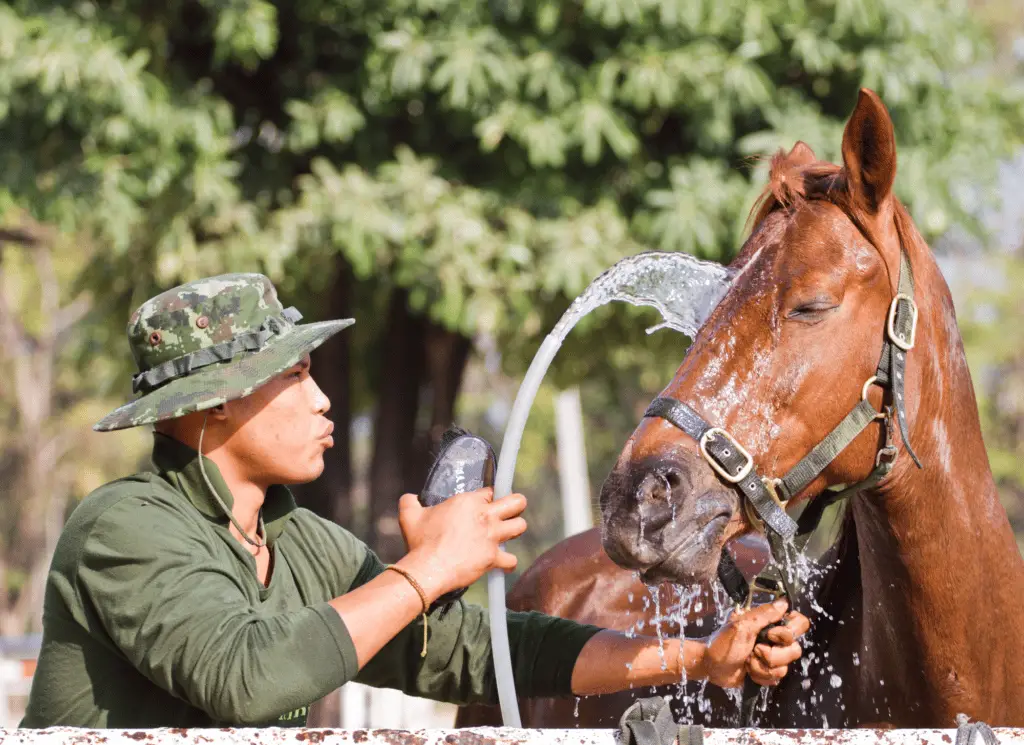I love winter—in part because my horse’s skin is so much better then. As soon as it gets warm, summer eczema tends to hit, and my horse’s skin starts with horrid itching and she starts scratching like mad.
I can see how irritable she becomes, and there have been days when she comes in from her rure with bloody scrapes from trying to bite and scratch and relieve the itchy skin.
Ah, every horse owner becomes familiar with the woes of dermatitis in horses at some point! But if it’s your first time, this guide will give you the rundown on what you need to know: what to look for, how to treat equine dermatitis, and more.
Medical Disclaimer: This article on horse dermatitis is not meant to diagnose or recommend treatment. Each horse’s unique conditions should be evaluated for a viable diagnosis. When you suspect a contagious cause of dermatitis, it’s always advisable to contact your vet for professional help.

What Is Equine Dermatitis?
Dermatitis, no matter which species it’s found in, is a localized irritation of the skin due to a range of different factors or causes.
On a visual level, equine dermatitis usually involves skin flaking, itching, swelling, and even discharge of fluid, blood, or pus. The horse’s skin may also build up scar tissue that can cause scars and thickened skin, which may even influence the horse’s ability to move, depending on the location of the dermatitis.
What Causes Dermatitis in Horses?
In horses, the irritation or dermatitis can result from allergies and cause atopic dermatitis, or it can occur because of bacterial and fungal infection. Insect bites, sunburn, damp weather or mud, and various microscopic culprits can all lead to dermatitis in horses.
Often, environmental factors such as the horse’s stall, their paddock, and the presence of their herd mates may cause the dermatitis infection.

6 Different Types of Dermatitis in Horses
Knowing which type of dermatitis your horse has contracted is the first step toward understanding how to help them and prevent the condition worsening or spreading.
1. Allergic Dermatitis in Horses (Atopic Dermatitis and Urticaria)
When horses are exposed to external factors that cause skin irritation, dermatitis is the result.
Signs: Dermatitis signs include swelling, bare patches of skin, irritation and scratching, alopecia (hair loss), and thickened skin—can be found on all parts of the horse’s body.
Causes: Allergic reaction triggered by insect bites, pollen, dust, sawdust, changes in weather, and even food.
Symptoms: General itchiness and hair loss from scratching and rubbing.
Treatment Options: Treating dermatitis caused by allergies depends on the cause of the particular dermatitis. Allergic dermatitis is often caused by external factors, so if the horse’s stall is dusty, they may have an allergic reaction to the dust particles. Changing their bedding or cleaning out more frequently may solve this issue in the long run.
Biting insects can also trigger allergic reactions, and flies and ticks may cause significant swelling and bumps on the horse’s skin. In this case, treatment would take the form of insect repellent sprays, injections to help clear out any blood-meal parasites, and stabling during the day when the insects are most active.
Some horses also suffer from heat exposure, and when the weather suddenly turns warm, the horse may develop hives or skin lesions.
A constant threat is secondary infections that may happen when the skin at a bite site becomes infected or acts as an entry point for bacterial matter that may trigger a topical infection. Treatment for atopic dermatitis may include injections with corticosteroids such as Prednisolone and over-the-counter antihistamines to help alleviate the allergic reaction.
Depending on the severity of the urticaria and pruritus (itching), your vet may also prescribe a long-acting antibiotic as a preventive measure for possible bacterial infection that may result from broken and scabby skin.
2. Pastern Dermatitis in Horses
When your horse suddenly goes lame and has swollen and oozing pasterns, chances are they have the classic pastern dermatitis, also known as mud fever or scratches.
Signs: In addition to the swelling, lameness, itchy skin, and scabbing of the pastern area, there may also be large raw blisters that can cover the entire back portion of the fetlock joint too.
Causes: The usual cause of pastern dermatitis is an infection by Dermatophilus spp., which is a bacterial organism seen under microscopic magnification as a “railroad” formation of cells. While this bacteria is normal and usually doesn’t affect horses negatively, the presence of a small insect bite or cut on the pastern gives these ambitious organisms an entry point to the horse’s skin.
Symptoms: Swelling of the pastern due to fluid buildup and poor circulation. Damp conditions and prolonged exposure to water can cause horses to quickly develop pastern dermatitis.
When the cause of the pastern dermatitis is not bacterial, there are other culprits to suspect such as photosensitivity, fleas, and/or crawling insects that plague the horse’s pastern area (especially when they have long feathers). If left untreated, the infected areas of the pasterns will crack, split, and begin to ooze exudate, which can further irritate and infect the skin site.
Over time, the pastern dermatitis can even develop into hoof rot and abscesses.
Treatment Options: The treatment plan for pastern dermatitis is quite involved, and the best success is found in a holistic approach. Regularly washing the affected areas with antibacterial shampoo containing benzoyl peroxide and alternating with antifungal shampoo can help limit the spread of this dermatitis.
Medicinal treatments include antibiotic injections like penicillin and Trimethoprim. Corticosteroids and other anti-inflammatories may also provide some relief.
3. Secondary Bacterial Infections of the Skin (Rainrot or Rain Scald)
When the horse’s skin has been compromised by physical injuries or bites, it creates a window of opportunity for bacterial infection to set in. Horses are commonly affected by rain rot and rain scald. Wet conditions and exposure to mud can trigger inflammation of the skin and hair follicles.
Signs: Bare patches on the horse’s spine, rump, and neck are usually indications of bacterial infection.
Causes: Bacteria, especially Dermatophilus congolensis, are the cause of rain rot, which is why the condition is medically known as dermatophilosis.
Symptoms: When the horse’s skin has been compromised due to excess moisture, a thick winter coat that doesn’t dry out, and insect bites or sunburn, inflammation sets in, which can cause exudate forming and leaking through the skin. Sores result and hair loss or alopecia follows. The skin may be tender, hot, and inflamed to the touch.
Treatment Options: Bath your horse with antimicrobial soap and remove any scabs that are loose enough, keeping in mind that the area is very sensitive. When the bacteria is exposed to air, dries out, and can’t reproduce, the horse’s skin will recover.
In extreme cases, antibiotic injections are required, such as penicillin, while corticosteroids may also be prescribed. Take care to wash your hands before moving from one horse to the next. While the bacteria are naturally occurring in horses, touching open cuts or scrapes on other horses may transfer a denser sample of bacteria-infused exudate, which can trigger a serious infection in the other horse.

4. Fungal Infection in Horses (Pyoderma, Ringworm)
While you may believe ringworm is something only cats and people get, horses are just as susceptible to it, especially when your horse’s immunity has been compromised by a recent illness. Interestingly, ringworm isn’t a worm—it’s a fungal infection. (Here is a more in-depth guide to ringworm in horses if you want to learn more.)
Signs: Round patches of bare skin with continued hair loss.
Causes: The primary cause of ringworm is the formation of fungal infections due to the presence of Trichophyton equinum and Trichophyton mentagrophytes.
Symptoms: Itching that results in scratching and hair loss, which creates the tell-tale round circles that we know of ringworm.
Treatment Options: While ringworm can clear up on its own in healthy horses, it’s still a good idea to use an antifungal shampoo to wash the affected area daily. Take care to wear gloves and keep any material that comes into contact with the fungus away from food sources and uninformed persons. Ringworms can transfer to humans.
When Pyoderma Deepens
In horses, one of the most severe skin infections is caused by microorganisms that opportunistically infect areas where fungi have “ripened” the skin. Staphylococcal folliculitis is one such organism, and it’s relentlessly tough to beat.
Staphylococcal folliculitis is a deep skin infection or pyoderma that affects the saddle and lumbar area of the horse. Usually, this condition flares in late summer or early winter when the horse’s thickened winter coat provides ideal breeding conditions.
Did you know? Horses can also suffer skin reactions to pinworms. We often see this condition in and around the dock of the horse’s tail. Small “pits” form where the worms burrow into the skin, and the itching is quite intense, which is why affected horses may rub their tails on stable walls and fences, leading to hair loss and increased scabs, exudate formation, and excessive granulation tissue or hardened skin.
5. Malassezia Infection of Mares’ Mammary Glands
While the mare’s mammary glands are not really in sight, there is a serious skin condition known as malassezia infection that can affect the delicate skin of their mammary glands. Malassezia, which is a type of yeast infection that targets the soft skin of the genitalia, pastern area, and glands like the mammary glands of a horse.
Signs: General discomfort and lameness in the back legs. Inflammation and exudate in the affected area with excessive skin shedding. Malessezia can also target the soft tissue of the horse’s ear pinna, forming dry pustules and crusts.
Causes: Exposure to damp conditions, muddy pastures, and other skin infections may cause the spread of malassezia infections in sensitive tissue.
Symptoms: Inflammation of the skin around the affected area may be severe, and crusting as well as excessive granulation can result, forming heavy scar tissue that can cause future problems.
Treatment Options: Washing the affected area with chlorhexidine shampoo is effective in clearing up these yeast infections.
6. Seborrhea (Equine Dandruff)
When your horse starts rubbing their mane and tail and dry skin flakes start to dislodge, chances are they have a case of seborrhea or equine dandruff.
Signs: Itchiness and excessive rubbing with scaling of the skin are typical of this condition.
Causes: Underlying causes are usually responsible for seborrhea, such as poor immunity, illness, or the formation of sarcoid, nutritional deficiency, tumors, imbalances, and digestive complications.
Symptoms: Itching, flaking skin, greasy and scaling coat and skin with bald patches forming where scabs remove the hair.
Treatment Options: Treatment requires that the original cause of the seborrhea is identified. Scrapings may be inconclusive due to the wide range of underlying causes that could be triggering the dandruff. Treat with topical medications that contain benzoyl peroxide, coal tar, and sulfur. Antifungal ointments may also prove beneficial.

Best Practice for Clear Skin in Your Horse
To keep your horse looking great, it’s important to follow these steps for best practice equine management:
- Feed balanced meals.
- Avoid excess sugar.
- Groom daily to check for signs of a dermal condition forming.
- Don’t share brushes and tack between horses to prevent cross contamination.
- Avoid excessive exposure to wet bedding, muddy paddocks, and wet grass.

More FAQs About Horse Dermatitis
How do you treat dermatitis in horses?
Injections of corticosteroids are the most effective treatment for most forms of dermatitis. Getting a definitive diagnosis of the type or cause of dermatitis your horse has will help narrow down the correct treatment for your horse’s dermatitis.
Why do horses have scabs on their legs?
Known as pastern dermatitis, scabby legs in horses indicate exposure to mud, poor circulation, photosensitivity, and bacterial infection. If left untreated, scabby legs can become very painful and can cause permanent scarring.
What does horse fungus look like?
Large areas where skin reactions result in the loss of hair, sensitivity, inflammation, and the formation of scabs may indicate fungal infection of your horse’s skin.

When it comes to horse skin conditions and dermal reactions, it’s always better to opt for prevention over cure.
Keeping a horse healthy, brushing regularly, bathing them to remove excess mud and dust, and responding with the relevant topical treatment as they need it is vital to keep the horse from developing allergic dermatitis, secondary infections, atopic dermatitis, and fungal infections.
Having the right veterinary medicine on hand to treat skin conditions immediately is also essential if you want to ensure your horse has a glossy coat free of blotches and alopecia.
Equine dermatology is still in its infancy, but with continued studies, it is becoming increasingly easier to identify the particular strain of a bacteria or fungi that has infected your horse’s dermis, which will make treatment much easier still.
Perhaps one of the worst affected areas for dermatitis is the pastern area. Horses are prone to serious infections, inflammation, and rashes behind and around their hooves, fetlock joints, and even lower legs. Find out more in my article on horse scratches.
Like this post? Save it on Pinterest. Follow me on Pinterest.


